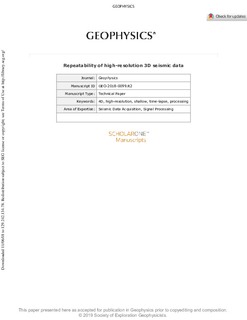| dc.contributor.author | Waage, Malin | |
| dc.contributor.author | Bünz, Stefan | |
| dc.contributor.author | Landrø, Martin | |
| dc.contributor.author | Plaza-Faverola, Andreia | |
| dc.contributor.author | Waghorn, Kate Alyse | |
| dc.date.accessioned | 2019-01-08T08:36:45Z | |
| dc.date.available | 2019-01-08T08:36:45Z | |
| dc.date.created | 2018-11-12T10:46:27Z | |
| dc.date.issued | 2018 | |
| dc.identifier.citation | Geophysics. 2018, 84 (1), B75-B94. | nb_NO |
| dc.identifier.issn | 0016-8033 | |
| dc.identifier.uri | http://hdl.handle.net/11250/2579564 | |
| dc.description.abstract | High-resolution 4D (HR4D) seismic data have the potential for improving the current state-of-the-art in detecting shallow (≤ 500 − 1000 m below seafloor) subsurface changes on a very fine scale (approximately 3–6 m). Time-lapse seismic investigations commonly use conventional broadband seismic data, considered low to moderate resolution in our context. We have developed the first comprehensive time -lapse analysis of high-resolution seismic data by assessing the repeatability of P-cable 3D seismic data (approximately 30–350 Hz) with short offsets and a high density of receivers. P-cable 3D seismic data sets have for decades been used to investigate shallow fluid flow and gas-hydrate systems. We analyze P-cable high-resolution 4D (HR4D) seismic data from three different geologic settings in the Arctic Circle. The first two are test sites with no evidence of shallow subsurface fluid flow, and the third is an active seepage site. Using these sites, we evaluate the reliability of the P-cable 3D seismic technology as a time-lapse tool and establish a 4D acquisition and processing workflow. Weather, waves, tide, and acquisition-parameters such as residual shot noise are factors affecting seismic repeatability. We achieve reasonable quantitative repeatability measures in stratified marine sediments at two test locations. However, repeatability is limited in areas that have poor penetration of seismic energy through the seafloor, such as glacial moraines or rough surface topography. The 4D anomalies in the active seepage site are spatially restricted to areas of focused fluid flow and might likely indicate changes in fluid flow. This approach can thus be applied to detect migration of fluids in active leakage structures, such as gas chimneys. | nb_NO |
| dc.language.iso | eng | nb_NO |
| dc.publisher | Society of Exploration Geophysicists | nb_NO |
| dc.title | Repeatability of high-resolution 3D seismic data | nb_NO |
| dc.type | Journal article | nb_NO |
| dc.type | Peer reviewed | nb_NO |
| dc.description.version | acceptedVersion | nb_NO |
| dc.source.pagenumber | B75-B94 | nb_NO |
| dc.source.volume | 84 | nb_NO |
| dc.source.journal | Geophysics | nb_NO |
| dc.source.issue | 1 | nb_NO |
| dc.identifier.doi | 10.1190/geo2018-0099.1 | |
| dc.identifier.cristin | 1629280 | |
| dc.relation.project | Norges forskningsråd: 223259 | nb_NO |
| dc.description.localcode | © 2019. This is the authors' accepted and refereed manuscript to the article. The final authenticated version is available online at: https://doi.org/10.1190/geo2018-0099.1 | nb_NO |
| cristin.unitcode | 194,63,35,0 | |
| cristin.unitname | Institutt for elektroniske systemer | |
| cristin.ispublished | true | |
| cristin.fulltext | original | |
| cristin.qualitycode | 2 | |
